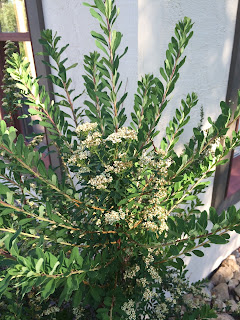Spirea in the Garden by Vicki Barney
I have several plants hiding in plain sight. Landscaped by the previous owner, my yard has a variety of cultivars tucked into inconspicuous places: hugging a wall, behind a showy perennial, hiding under bushes, and the like. A white flowering spirea bush is one of them.
Spirea plants (genus Spiraea), part of the Rosaceae family, are deciduous shrubs of various sizes. They are low maintenance, hardy, prolific bloomers and are a great addition to any garden. Some species bloom in the spring, others in summer, and the showy tiny flowers grow in clusters along woody stems. Flower colors may be pink, red, yellow, or white, depending on the variety. Most varieties tolerate poor soil, need a lot of sun, like to have room to spread out, and do not like wet feet. While they are not classified as xeric, they can manage with little water once established. Their flowers are more prolific, however, with regular summer watering, and mulch around the plants help retain moisture.
As for plant selection, cultivated varieties are numerous, the species being a horticultural favorite for generations. The small (2-3 ft) pink flowering varieties of s. japonica are popular, as is the large bridal wreath species (s. prunifolia) which may grow up to 10 feet tall (take note that these two species may not be hardy above 7,500’). The native spirea (holodiscus dumosus), called rock-spirea or mountainspray, has white flowers and is a good choice for a natural landscape. The Blue Mist Spirea is another popular plant but, do not be confused, it is a spirea in name only and is a cultivar in the genus caryopteris, part of the Lamiaceae family.
While spirea is low maintenance, it benefits from annual pruning. Spring bloomers like s. prunifolia should be pruned after flowering as they bloom on old wood. Pruning helps them keep their shape and size, and cutting out the oldest stems prevents them from becoming woody and unproductive. For summer bloomers (like varieties of s. japonica), recommended pruning time is early spring, after allowing the larger plant to have a mound of protection through the winter. Pruning a plant in half in early spring will result in a more compact shrub with abundant flowers on new wood.
Best of all, spirea appears to be unappetizing to wildlife. My garden is visited by both deer and moose and, while they nibble on the red osier dogwood, the pansies, and the daylilies, they leave the spirea alone. It must not taste very good.
My white flowering spirea is a mystery variety that blooms in the spring. Parts of the bush look quite healthy but other parts are woody and produce no flowers. As a spring bloomer, it will benefit from pruning after it finishes flowering, to improve its shape and to remove old woody stems. It may also benefit from a bit more water in the driest part of the summer, but I will be careful with the water to be sure it does not get too wet or grow too large in its location next to the wall. Now that I have noticed it, I like how it hides in plain sight.
A long time Steamboat resident and casual gardener, Vicky Barney is a member of the Master Gardener Class of 2011.




Comments
Post a Comment